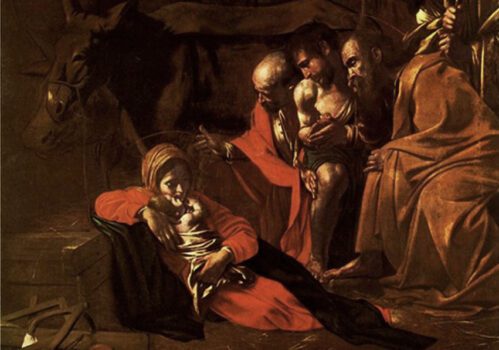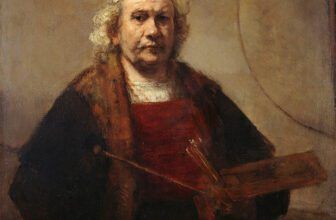Meaning of Caravaggio’s The Adoration of the Shepherds
When Michelangelo Merisi da Caravaggio painted The Adoration of the Shepherds in 1609, he was in the twilight of his turbulent life. Exiled from Rome after a murder charge and moving between Naples, Malta, and Sicily, Caravaggio carried with him a darkness born of constant flight, violence, and spiritual unease. Yet even amidst his turmoil, he produced one of the most striking and intimate depictions of the Nativity ever painted. Today, this masterpiece resides in Messina, Sicily, within the Regional Museum of Messina, and continues to astonish viewers with its profound simplicity, radical realism, and spiritual intensity.
This story-like exploration will examine The Adoration of the Shepherds in detail: how Caravaggio painted it, what is happening in the scene, the symbolism and meaning behind its imagery, the type of art it represents, and the reasons it stands apart from earlier depictions of the same biblical episode.
What is The Adoration of the Shepherds Painting Represents
The story of the Adoration of the Shepherds comes from the Gospel of Luke (Luke 2:8–20). After Jesus’ birth in Bethlehem, angels appeared to shepherds in nearby fields, announcing the good news of the Savior’s arrival. The shepherds, humble and poor, were among the first to witness and honor the newborn Christ, marking the inclusivity of salvation: God revealed Himself not to kings or scholars first, but to common workers of the land.
Traditional Renaissance and Baroque paintings of this subject often emphasized heavenly glory, angels in the sky, halos glowing, rich colors, and ornate surroundings. But Caravaggio stripped away that splendor. His vision was earthy, grounded, and immediate. Instead of gilded cradles and radiant angels, Caravaggio gives us a barn that looks nearly like a ruin, a simple bed of straw, and weary figures who resemble ordinary peasants kneeling in awe.
This choice sets the tone: The Adoration of the Shepherds is about humility, realism, and the sacred presence of God in the most ordinary of circumstances.
How Caravaggio Painted The Adoration of the Shepherds
Caravaggio’s technique is famous for its use of chiaroscuro, the dramatic contrast of light and dark. In this work, the dim stable is pierced by a muted but focused light source that illuminates the infant Jesus, Mary, and the kneeling shepherds. The effect is theatrical but intimate, resembling a spotlight in a stage play.
Caravaggio’s method was revolutionary because he painted directly from life. He did not rely on idealized sketches or classical prototypes, as many Renaissance artists did. Instead, he hired models from the streets, peasants, beggars, workers, even prostitutes, and set them up in real environments. He painted their rough hands, weathered faces, and soiled garments without apology. In The Adoration of the Shepherds, this approach creates figures that feel startlingly human and approachable.
Mary is portrayed as a tired, solemn mother, cradling her newborn with quiet tenderness. Joseph is pushed into the shadows, as Caravaggio often depicted him, a background figure of humility. The shepherds appear rugged, their postures awkward yet reverent, as though they are overwhelmed by the mystery before them.
The composition is simple: all figures are gathered in a triangular arrangement, with the baby at the center of attention. The stable is dark and unadorned, reminding viewers of Christ’s humble beginnings. There is no angelic choir painted above, no golden glow, just human presence and divine light shining from the child.
What is Happening in The Adoration of the Shepherds Painting?
At first glance, the scene may appear almost uneventful. Unlike earlier Nativity scenes brimming with angels, animals, and celebratory bustle, Caravaggio’s canvas is nearly austere. But the quietness is intentional, it amplifies the significance of the shepherds’ reverence.
Here is the narrative distilled into visual form:
The Infant Jesus lies at the heart of the composition, the luminous center. His placement on the ground, resting on a thin bed of straw, underscores the humility of the Incarnation.
Mary sits close to Him, her body curved protectively, her expression solemn and contemplative rather than exalted. She is the human mother, exhausted from childbirth, aware of the gravity of her child’s destiny.
Joseph is present but receded, his figure blending into the shadows. Caravaggio often portrayed Joseph as quiet, humble, almost invisible, a reminder of his supportive but secondary role in salvation history.
The Shepherds lean in, their hands clasped, bodies bent in awe. Their expressions show wonder mixed with uncertainty. They are not idealized shepherds from pastoral poetry; they are real men, unwashed and rugged, kneeling before mystery.
The stillness of the painting conveys that this is not about narrative action but about spiritual recognition. The shepherds embody humanity encountering the divine for the first time in flesh.
Symbolism and Meaning of The Adoration of the Shepherds Painting
Caravaggio’s paintings are often layered with symbolic meaning, even when stripped of decorative excess. In The Adoration of the Shepherds, several symbolic elements emerge:
The Humble Setting
The ruined stable suggests both poverty and transience. It reminds viewers that Christ was born not in comfort but in hardship, and that salvation enters history in the most unexpected of places.The Light
Unlike other artists who painted a golden glow emanating from Christ Himself, Caravaggio uses an external, directional light that falls across the child and those around Him. Symbolically, it suggests divine illumination entering the darkness of the world.The Shepherds’ Hands and Postures
Their clasped hands and bent knees symbolize humility and reverence. Their rough, earthy bodies are reminders that God comes first to the poor and lowly.Mary’s Expression
Unlike earlier depictions of the Virgin smiling serenely, Caravaggio paints Mary with gravity and weariness. This may symbolize her awareness of the suffering that awaits her son. It connects the Nativity to the Crucifixion, binding joy and sorrow in one image.The Absence of Angels
By omitting angelic choirs, Caravaggio directs the viewer’s focus to the human response. The sacred event is mediated through ordinary human experience rather than supernatural spectacle.
Through these choices, Caravaggio crafts a painting that is not about visual splendor but about theological depth, the paradox of divine majesty revealed through human poverty.
The Artistic Style: Baroque Realism
Caravaggio’s The Adoration of the Shepherds is a quintessential example of Italian Baroque art, specifically his own radical form of naturalistic realism. The Baroque period emphasized drama, emotion, and theatricality, often using bold contrasts of light and shadow to evoke awe. But Caravaggio’s version of Baroque was different from the ornamental grandeur of artists like Rubens or Bernini. His drama lay not in lavish decoration but in stripping things down to their raw essentials.
Key characteristics of Caravaggio’s style in this work:
Chiaroscuro (tenebrism): The dramatic play of shadow and light, heightening spiritual intensity.
Naturalism: Figures look like real people, not idealized or beautified. Their flaws and fatigue are visible.
Simplicity of Composition: Few figures, arranged in an intimate grouping, with no distractions.
Psychological Realism: The emotions of awe, humility, and contemplation are conveyed not through exaggerated gestures but through subtle posture and expression.
This was revolutionary in its time. Many church patrons initially resisted Caravaggio’s realism, accusing him of making sacred figures too ordinary. Yet this very ordinariness is what continues to make his works so powerful today.
Caravaggio painted The Adoration of the Shepherds in 1609 for the Capuchin Church of Santa Maria degli Angeli in Messina. At this point, he was a fugitive. Only a few years earlier, he had fled Rome after killing a man in a street brawl. His life became a restless journey between Naples, Malta, and Sicily, as he sought both commissions and papal pardon.
In Sicily, Caravaggio produced several deeply moving religious works, including this Nativity scene. The Capuchins, known for their emphasis on poverty and humility, found Caravaggio’s style well-suited to their spiritual values. His realistic depiction of the shepherds mirrored the order’s focus on simplicity, poverty, and closeness to the common people.
It is significant that, during this dark chapter of his life, Caravaggio produced one of his most tender works. Some scholars suggest that the painting reflects the artist’s own longing for grace and redemption.
Where The Adoration of the Shepherds Painting Is Located Today
The Adoration of the Shepherds is currently housed in the Museo Regionale Interdisciplinare di Messina (Regional Museum of Messina) in Sicily, Italy. After the devastating 1908 earthquake in Messina destroyed much of the city and its churches, the painting was preserved and eventually became part of the museum’s collection.
Today, visitors can see it in Messina alongside other masterpieces of Sicilian and Italian art. The painting remains one of the highlights of the museum, drawing art lovers, historians, and pilgrims alike.
Why The Adoration of the Shepherds Painting Still Matters
Caravaggio’s The Adoration of the Shepherds matters because it continues to speak across centuries. Unlike more ornate Nativities that might feel distant to modern viewers, Caravaggio’s version feels raw and close. The shepherds could be anyone, laborers, refugees, the poor on city streets today.
The painting reminds us that divinity does not always appear with grandeur but often in humility, vulnerability, and the margins of society. It resonates not just as a religious image but as a meditation on human dignity, poverty, and hope.
Caravaggio’s The Adoration of the Shepherds is not a painting of spectacle but of intimacy. It is not a hymn of triumph but a quiet meditation on humility, poverty, and awe. Through chiaroscuro, realism, and symbolic simplicity, Caravaggio transforms a biblical story into an encounter that feels real and present.
The shepherds kneel, their hands rough, their knees bent. Mary cradles her child, weary yet solemn. Joseph lingers in the shadows. And at the center, the newborn Christ lies vulnerable in straw. In that fragile image, Caravaggio presents the paradox of Christianity: God incarnate, infinite majesty in humble flesh.
From its origins in Messina to its enduring presence in the museum today, the painting continues to invite viewers into that moment of wonder. Caravaggio, the restless genius who lived on the edge of violence and exile, somehow distilled his tumultuous spirit into this vision of stillness, an eternal night pierced by a light that refuses to be extinguished.




